MSP 学习笔记 初识开发板和IDE
第5章 IDE介绍

版本: 版本: 1、unSP IDE 1.8.4 、 2、unSP IDE2.0.0推出时间:2005-11 推出时间: 、 推出时间 特点: 安装软件、 特点:unSP IDE2.0.0安装软件、unSP IDE2.0.0 安装软件 简述。支持Vista操作系统!凌阳 位单片机的在 操作系统! 简述。支持 操作系统 凌阳16位单片机的在 线编译环境,可支持在线编译、烧录下载。支持 线编译环境,可支持在线编译、烧录下载。 SPCE061A和SPMC701开发,支持 开发, 和 开发 EZ_Probe,Probe在线仿真,支持 语言与汇编混 在线仿真, 在线仿真 支持C语言与汇编混 合编程。 合编程。 3、 unSP IDE 2.6.2D 、 推出时间:2008-06 推出时间: 特点:unSPIDE_V2.6.2D安装文件,支持 特点: 安装文件, 安装文件 支持Vista 操作系统!凌阳16位单片机的在线编译环境 位单片机的在线编译环境, 操作系统!凌阳 位单片机的在线编译环境,可 支持在线编译、烧录下载。支持SPCE061A和 支持在线编译、烧录下载。支持 和 SPMC701开发,支持 开发, 在线仿真, 开发 支持EZ_Probe,Probe在线仿真, 在线仿真 支持C语言与汇编混合编程 语言与汇编混合编程。 支持 语言与汇编混合编程。
加载库: 加载库:
’nSP IDE的主要特点 的主要特点
提供了友好的交互界面、易于操作,使调 提供了友好的交互界面、易于操作, 试工作方便且高效。 试工作方便且高效。 集程序编辑、编译、链接、调试和仿真等 集程序编辑、编译、链接、 功能为一体。 功能为一体。 提供软件仿真功能,可以在不连接仿真板 提供软件仿真功能, 的情况下,模拟硬件部分功能。 的情况下,模拟硬件部分功能。
STM32F20xxx_21xxx单片机硬件开发入门笔记
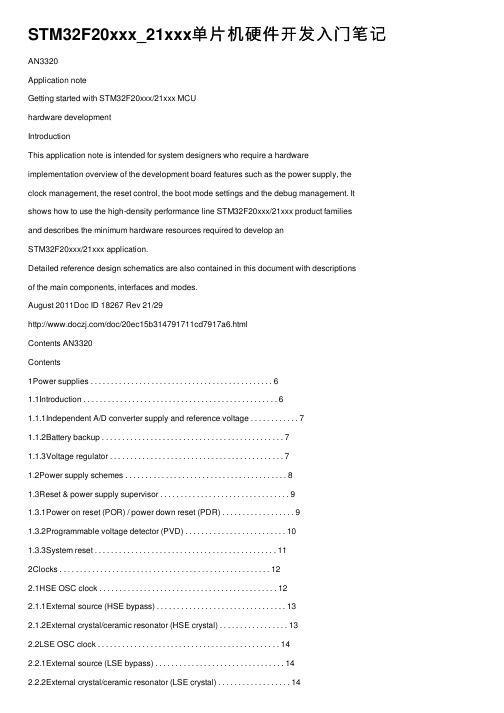
STM32F20xxx_21xxx单⽚机硬件开发⼊门笔记AN3320Application noteGetting started with STM32F20xxx/21xxx MCUhardware developmentIntroductionThis application note is intended for system designers who require a hardwareimplementation overview of the development board features such as the power supply, theclock management, the reset control, the boot mode settings and the debug management. It shows how to use the high-density performance line STM32F20xxx/21xxx product familiesand describes the minimum hardware resources required to develop anSTM32F20xxx/21xxx application.Detailed reference design schematics are also contained in this document with descriptionsof the main components, interfaces and modes.August 2011Doc ID 18267 Rev 21/29/doc/20ec15b314791711cd7917a6.htmlContents AN3320Contents1Power supplies . . . . . . . . . . . . . . . . . . . . . . . . . . . . . . . . . . . . . . . . . . . . . 61.1Introduction . . . . . . . . . . . . . . . . . . . . . . . . . . . . . . . . . . . . . . . . . . . . . . . . 61.1.1Independent A/D converter supply and reference voltage . . . . . . . . . . . . 71.1.2Battery backup . . . . . . . . . . . . . . . . . . . . . . . . . . . . . . . . . . . . . . . . . . . . . 71.1.3Voltage regulator . . . . . . . . . . . . . . . . . . . . . . . . . . . . . . . . . . . . . . . . . . . 71.2Power supply schemes . . . . . . . . . . . . . . . . . . . . . . . . . . . . . . . . . . . . . . . . 81.3Reset & power supply supervisor . . . . . . . . . . . . . . . . . . . . . . . . . . . . . . . . 91.3.1Power on reset (POR) / power down reset (PDR) . . . . . . . . . . . . . . . . . . 91.3.2Programmable voltage detector (PVD) . . . . . . . . . . . . . . . . . . . . . . . . . 101.3.3System reset . . . . . . . . . . . . . . . . . . . . . . . . . . . . . . . . . . . . . . . . . . . . . 112Clocks . . . . . . . . . . . . . . . . . . . . . . . . . . . . . . . . . . . . . . . . . . . . . . . . . . . . 122.1HSE OSC clock . . . . . . . . . . . . . . . . . . . . . . . . . . . . . . . . . . . . . . . . . . . . 122.1.1External source (HSE bypass) . . . . . . . . . . . . . . . . . . . . . . . . . . . . . . . . 132.1.2External crystal/ceramic resonator (HSE crystal) . . . . . . . . . . . . . . . . . 132.2LSE OSC clock . . . . . . . . . . . . . . . . . . . . . . . . . . . . . . . . . . . . . . . . . . . . . 142.2.1External source (LSE bypass) . . . . . . . . . . . . . . . . . . . . . . . . . . . . . . . . 142.2.2External crystal/ceramic resonator (LSE crystal) . . . . . . . . . . . . . . . . . . 142.3Clock security system (CSS) . . . . . . . . . . . . . . . . . . . . . . . . . . . . . . . . . . 153Boot configuration . . . . . . . . . . . . . . . . . . . . . . . . . . . . . . . . . . . . . . . . . 163.1Boot mode selection . . . . . . . . . . . . . . . . . . . . . . . . . . . . . . . . . . . . . . . . . 163.2Boot pin connection . . . . . . . . . . . . . . . . . . . . . . . . . . . . . . . . . . . . . . . . . 163.3Embedded boot loader mode . . . . . . . . . . . . . . . . . . . . . . . . . . . . . . . . . . 174Debug management . . . . . . . . . . . . . . . . . . . . . . . . . . . . . . . . . . . . . . . . 184.1Introduction . . . . . . . . . . . . . . . . . . . . . . . . . . . . . . . . . . . . . . . . . . . . . . . 184.2SWJ debug port (serial wire and JTAG) . . . . . . . . . . . . . . . . . . . . . . . . . . 184.3Pinout and debug port pins . . . . . . . . . . . . . . . . . . . . . . . . . . . . . . . . . . . 184.3.1SWJ debug port pins . . . . . . . . . . . . . . . . . . . . . . . . . . . . . . . . . . . . . . . 184.3.2Flexible SWJ-DP pin assignment . . . . . . . . . . . . . . . . . . . . . . . . . . . . . . 194.3.3Internal pull-up and pull-down resistors on JT AG pins . . . . . . . . . . . . . . 194.3.4SWJ debug port connection with standard JTAG connector . . . . . . . . . 20 2/29 Doc ID 18267 Rev 2AN3320Contents5Recommendations . . . . . . . . . . . . . . . . . . . . . . . . . . . . . . . . . . . . . . . . . 215.1Printed circuit board . . . . . . . . . . . . . . . . . . . . . . . . . . . . . . . . . . . . . . . . . 215.2Component position . . . . . . . . . . . . . . . . . . . . . . . . . . . . . . . . . . . . . . . . . 215.3Ground and power supply (V SS, V DD) . . . . . . . . . . . . . . . . . . . . . . . . . . . 215.4Decoupling . . . . . . . . . . . . . . . . . . . . . . . . . . . . . . . . . . . . . . . . . . . . . . . . 215.5Other signals . . . . . . . . . . . . . . . . . . . . . . . . . . . . . . . . . . . . . . . . . . . . . . 225.6Unused I/Os and features . . . . . . . . . . . . . . . . . . . . . . . . . . . . . . . . . . . . 226Reference design . . . . . . . . . . . . . . . . . . . . . . . . . . . . . . . . . . . . . . . . . . 236.1Description . . . . . . . . . . . . . . . . . . . . . . . . . . . . . . . . . . . . . . . . . . . . . . . . 236.1.1Clock . . . . . . . . . . . . . . . . . . . . . . . . . . . . . . . . . . . . . . . . . . . . . . . . . . . 236.1.2Reset . . . . . . . . . . . . . . . . . . . . . . . . . . . . . . . . . . . . . . . . . . . . . . . . . . . 236.1.3Boot mode . . . . . . . . . . . . . . . . . . . . . . . . . . . . . . . . . . . . . . . . . . . . . . . 236.1.4SWJ interface . . . . . . . . . . . . . . . . . . . . . . . . . . . . . . . . . . . . . . . . . . . . . 236.1.5Power supply . . . . . . . . . . . . . . . . . . . . . . . . . . . . . . . . . . . . . . . . . . . . . 236.2Component references . . . . . . . . . . . . . . . . . . . . . . . . . . . . . . . . . . . . . . . 24 7Revision history . . . . . . . . . . . . . . . . . . . . . . . . . . . . . . . . . . . . . . . . . . . 28Doc ID 18267 Rev 23/29List of tables AN3320 List of tablesTable 1.Boot modes. . . . . . . . . . . . . . . . . . . . . . . . . . . . . . . . . . . . . . . . . . . . . . . . . . . . . . . . . . . . . 16 Table 2.Debug port pin assignment. . . . . . . . . . . . . . . . . . . . . . . . . . . . . . . . . . . . . . . . . . . . . . . . . 19 Table 3.SWJ I/O pin availability. . . . . . . . . . . . . . . . . . . . . . . . . . . . . . . . . . . . . . . . . . . . . . . . . . . . 19 Table 4.Mandatory components . . . . . . . . . . . . . . . . . . . . . . . . . . . . . . . . . . . . . . . . . . . . . . . . . . . 24 Table 5.Optional components . . . . . . . . . . . . . . . . . . . . . . . . . . . . . . . . . . . . . . . . . . . . . . . . . . . . . 24 Table 6.Reference connection for all packages. . . . . . . . . . . . . . . . . . . . . . . . . . . . . . . . . . . . . . . . 26 Table 7.Document revision history . . . . . . . . . . . . . . . . . . . . . . . . . . . . . . . . . . . . . . . . . . . . . . . . . 28 4/29 Doc ID 18267 Rev 2AN3320List of figures List of figuresFigure 1.Power supply overview. . . . . . . . . . . . . . . . . . . . . . . . . . . . . . . . . . . . . . . . . . . . . . . . . . . . . 6 Figure 2.Power supply scheme. . . . . . . . . . . . . . . . . . . . . . . . . . . . . . . . . . . . . . . . . . . . . . . . . . . . . . 9 Figure 3.Power-on reset/power-down reset waveform. . . . . . . . . . . . . . . . . . . . . . . . . . . . . . . . . . . 10 Figure 4.PVD thresholds. . . . . . . . . . . . . . . . . . . . . . . . . . . . . . . . . . . . . . . . . . . . . . . . . . . . . . . . . . 10 Figure 5.Reset circuit . . . . . . . . . . . . . . . . . . . . . . . . . . . . . . . . . . . . . . . . . . . . . . . . . . . . . . . . . . . . 11 Figure 6.HSE external clock. . . . . . . . . . . . . . . . . . . . . . . . . . . . . . . . . . . . . . . . . . . . . . . . . . . . . . . 12 Figure 7.HSE crystal/ceramic resonators. . . . . . . . . . . . . . . . . . . . . . . . . . . . . . . . . . . . . . . . . . . . . 12 Figure 8.LSE external clock . . . . . . . . . . . . . . . . . . . . . . . . . . . . . . . . . . . . . . . . . . . . . . . . . . . . . . . 14 Figure 9.LSE crystal/ceramic resonators . . . . . . . . . . . . . . . . . . . . . . . . . . . . . . . . . . . . . . . . . . . . . 14 Figure 10.Boot mode selection implementation example. . . . . . . . . . . . . . . . . . . . . . . . . . . . . . . . . . 16 Figure 11.Host-to-board connection. . . . . . . . . . . . . . . . . . . . . . . . . . . . . . . . . . . . . . . . . . . . . . . . . . 18 Figure 12.JTAG connector implementation . . . . . . . . . . . . . . . . . . . . . . . . . . . . . . . . . . . . . . . . . . . . 20 Figure 13.Typical layout for V DD/V SS pair . . . . . . . . . . . . . . . . . . . . . . . . . . . . . . . . . . . . . . . . . . . . . 22 Figure 14.STM32F207IG(H6) microcontroller reference schematic. . . . . . . . . . . . . . . . . . . . . . . . . . 25Doc ID 18267 Rev 25/29Power supplies AN33206/29 Doc ID 18267 Rev 21 Power supplies1.1 IntroductionThe device requires a 1.8V to 3.6V operating voltage supply (V DD ), excepted the WLCSPpackage witch requires 1.65V to 3.6V. An embedded regulator is used to supply the internal 1.2V digital power.The real-time clock (RTC) and backup registers can be powered from the V BAT voltage when the main V DD supply is powered off.1.V DDA and V SSA must be connected to V DD and V SS , respectively.2.The voltage on V REF ranges from 1.65V to V DDA for WLCSP64+2 packages.AN3320Power suppliesDoc ID 18267 Rev 27/291.1.1 Independent A/D converter supply and reference voltageTo improve conversion accuracy, the ADC has an independent power supply that can be filtered separately, and shielded from noise on the PCB.●the ADC voltage supply input is available on a separate V DDA pin ●an isolated supply ground connection is provided on the V SSA pinWhen available (depending on package), V REF– must be tied to V SSA .On 100-pin package and above and on WLCSP64+2To ensure a better accuracy on low-voltage inputs, the user can connect a separate external reference voltage ADC input on V REF+. The voltage on V REF+ may range from 1.8V to V DDA . On WLCSP64+2, the V REF- pin is not available, it is internally connected to the ADC ground (V SSA ).On 64-pin packagesThe V REF+ and V REF- pins are not available, they are internally connected to the ADC voltage supply (V DDA ) and ground (V SSA ).1.1.2 Battery backupTo retain the content of the Backup registers when V DD is turned off, the V BAT pin can beconnected to an optional standby voltage supplied by a battery or another source.The V BAT pin also powers the RTC unit, allowing the RTC to operate even when the main digital supply (V DD ) is turned off. The switch to the V BAT supply is controlled by the power down reset (PDR) circuitry embedded in the Reset block.If no external battery is used in the application, it is highly recommended to connect V BAT externally to V DD .1.1.3 Voltage regulatorThe voltage regulator is always enabled after reset. It works in three different modesdepending on the application modes.●in Run mode, the regulator supplies full power to the 1.2V domain (core, memories and digital peripherals)●in Stop mode, the regulator supplies low power to the 1.2V domain, preserving the contents of the registers and SRAM●in Standby mode, the regulator is powered down. The contents of the registers and SRAM are lost except for those concerned with the Standby circuitry and the Backup domain.Note:Depending on the selected package, there are specific pins that should be connected either to V SS or V DD to activate or deactivate the voltage regulator. Refer to section "Voltage regulator" in STM32F20xxx/21xxx datasheet for details .Power supplies AN33208/29 Doc ID 18267 Rev 21.2 Power supply schemesThe circuit is powered by a stabilized power supply, V DD .●Caution:–The V DD voltage range is 1.8V to 3.6V (and 1.65V to 3.6V for WLCSP64+2 package)●The V DD pins must be connected to V DD with external decoupling capacitors: one single T antalum or Ceramic capacitor (min. 4.7µF typ.10µF) for the package + one 100nF Ceramic capacitor for each V DD pin.●The V BAT pin can be connected to the external battery (1.65V < V BA T < 3.6V). If no external battery is used, it is recommended to connect this pin to V DD with a 100nF external ceramic decoupling capacitor.●The V DDA pin must be connected to two external decoupling capacitors (100nF Ceramic + 1µF Tantalum or Ceramic).●The V REF+ pin can be connected to the V DDA external power supply. If a separate, external reference voltage is applied on V REF+, a 100nF and a 1µF capacitors must be connected on this pin. In all cases, V REF+ must be kept between 1.65V and V DDA .●Additional precautions can be taken to filter analog noise:–V DDA can be connected to V DD through a ferrite bead.–The V REF+ pin can be connected to V DDA through a resistor (typ. 47Ω).●For the voltage regulator configuration, there are specific pins (REGOFF and IRROFF depending on the package) that should be connected either to VSS or VDD to activate or deactivate the voltage regulator specific. Refer to section "Voltage regulator" in STM32F20xxx/21xxx datasheet for details .●When the voltage regulator is enabled, V CAP1 and V CAP2 pins must be connected to 2*2.2µF Ceramic capacitor.AN3320Power suppliesDoc ID 18267 Rev 29/291.Optional. If a separate, external reference voltage is connected on V REF+, the two capacitors (100 nF and1µF) must be connected.2.V REF + is either connected to V REF or to V DDA .3.N is the number of V DD and V SS inputs.4.Refer to section "Voltage regulator" in STM32F20xxx/21xxx datasheet to connect REGOFF and IRROFFpins.1.3Reset & power supply supervisor1.3.1Power on reset (POR) / power down reset (PDR)The device has an integrated POR/PDR circuitry that allows proper operation starting from 1.8V .The device remains in the Reset mode as long as V DD is below a specified threshold, V POR/PDR , without the need for an external reset circuit. For more details concerning the power on/power down reset threshold, refer to the electrical characteristics in STM32F20xxx/21xxx datasheets.On WLCSP66 package if IRROFF pin is set to V DD (in that case REGOFF pin must not be activated, refer to section "Voltage regulator" in STM32F20xxx/21xxx datasheet for details ), the PDR is not functional. Then the V DD can lower below 1.8V , but the external circuitry must ensure that reset pin is activated when V DD /V DDA becomes below 1.65V .Power suppliesAN332010/29 Doc ID 18267 Rev 21.t RSTTEMPO is approximately2.6ms. V POR/PDR rising edge is 1.74V (typ.) and V POR/PDR falling edge is1.70V (typ.). Refer to STM32F20xxx/21xxx datasheets for actual value.1.3.2 Programmable voltage detector (PVD)Y ou can use the PVD to monitor the V DD power supply by comparing it to a thresholdselected by the PLS[2:0] bits in the Power control register (PWR_CR).The PVD is enabled by setting the PVDE bit.A PVDO flag is available, in the Power control/status register (PWR_CSR), to indicatewhether V DD is higher or lower than the PVD threshold. This event is internally connected to EXTI Line16 and can generatean interrupt if enabled through the EXTI registers. The PVD output interrupt can be generated when V DD drops below the PVD threshold and/or when VDD rises above the PVD threshold depending on the EXTI Line16 rising/falling edge configuration. As an example the service routine can perform emergency shutdown tasks.AN3320Power suppliesDoc ID 18267 Rev 211/291.3.3 System resetA system reset sets all registers to their reset values except for the reset flags in the clockcontroller CSR register and the registers in the Backup domain (see Figure 1).A system reset is generated when one of the following events occurs:1. A low level on the NRST pin (external reset)2. window watchdog end-of-count condition (WWDG reset)3. Independent watchdog end-of-count condition (IWDG reset)4. A software reset (SW reset)5.Low-power management resetThe reset source can be identified by checking the reset flags in the Control/Status register, RCC_CSR.The STM32F20xxx/21xxx does not require an external reset circuit to power-up correctly. Only a pull-down capacitor is recommended to improve EMS performance by protecting the device against parasitic resets. See Figure 5.Charging and discharging a pull-down capacitor through an internal resistor increases the device power consumption. The capacitor recommended value (100nF) can be reduced to 10nF to limit this power consumption;Clocks AN332012/29 Doc ID 18267 Rev 22 ClocksThree different clock sources can be used to drive the system clock (SYSCLK):●HSI oscillator clock (high-speed internal clock signal)●HSE oscillator clock (high-speed external clock signal)●PLL clockThe devices have two secondary clock sources:●32kHz low-speed internal RC (LSI RC) that drives the independent watchdog and, optionally, the RTC used for Auto-wakeup from the Stop/Standby modes.●32.768kHz low-speed external crystal (LSE crystal) that optionally drives the real-time clock (RTCCLK)Each clock source can be switched on or off independently when it is not used, to optimize the power consumption.Refer to the STM32F20xxx/21xxx reference manual RM0033 for the description of the clock tree.2.1 HSE OSC clockThe high-speed external clock signal (HSE) can be generated from two possible clock sources:●HSE external crystal/ceramic resonator (see Figure 7)●HSE user external clock (see Figure 6)1.The value of R EXT depends on the crystal characteristics. Typical value is in the range of 5 to 6 R S(resonator series resistance).2.Load capacitance C L has the following formula: C L = C L1 x C L2 / (C L1 + C L2) + C stray where: C stray is the pincapacitance and board or trace PCB-related capacitance. Typically, it is between 2pF and 7pF. Please refer to Section 5: Recommendations on page 21 to minimize its value.Figure 6.HSE external clockFigure 7.HSE crystal/ceramicAN3320ClocksDoc ID 18267 Rev 213/292.1.1 External source (HSE bypass)In this mode, an external clock source must be provided. It can have a frequency from 1 to 16MHz (refer toSTM32F20xxx/21xxx datasheets for actual max value).The external clock signal (square, sine or triangle) with a duty cycle of about 50%, has to drive the OSC_IN pin while the OSC_OUT pin must be left in the high impedance state (see Figure 7 and Figure 6).2.1.2 External crystal/ceramic resonator (HSE crystal)The external oscillator frequency ranges from 4 to 26MHz.The external oscillator has the advantage of producing a very accurate rate on the mainclock. The associated hardware configuration is shown in Figure 7. Using a 25MHz oscillator frequency is a good choice to get accurate Ethernet, USB OTG high-speed peripheral, and I 2S.The resonator and the load capacitors have to be connected as close as possible to the oscillator pins in order to minimize output distortion and startup stabilization time. The load capacitance values must be adjusted according to the selected oscillator.For C L1 and C L2 it is recommended to use high-quality ceramic capacitors in the 5pF-to-25pF range (typ.), designed for high-frequency applications and selected to meet the requirements of the crystal or resonator. C L1 and C L2, are usually the same value. Thecrystal manufacturer typically specifies a load capacitance that is the series combination of C L1 and C L2. The PCB andMCU pin capacitances must be included when sizing C L1 and C L2 (10 pF can be used as a rough estimate of the combined pin and board capacitance).Refer to the electrical characteristics sections in the datasheet of your product for more details.Clocks AN332014/29 Doc ID 18267 Rev 22.2 LSE OSC clockThe low-speed external clock signal (LSE) can be generated from two possible clocksources:●LSE external crystal/ceramic resonator (see Figure 9)●LSE user external clock (see Figure 8)1.“LSE crystal/ceramic resonators” figure:To avoid exceeding the maximum value of C L1 and C L2 (15pF) it is strongly recommended to use a resonator with a load capacitance C L ≤7pF. Never use a resonator with a load capacitance of 12.5pF.2.“LSE external clock” and “LSEcrystal/ceramic resonators” figures:OSC32_IN and OSC32_OUT pins can be used also as GPIO, but it is recommended not to use them as both RTC and GPIO pins in the same application.3.“LSE crystal/ceramic resonators” figure:The value of R EXT depends on the crystal characteristics. A 0Ω resistor would work but would not be optimal. To fine tube R S value, refer to AN2867 - Oscillator design guide for ST microcontrollers.2.2.1 External source (LSE bypass)In this mode, an external clock source must be provided. It can have a frequency of up to 1MHz. The external clock signal (square, sine or triangle) with a duty cycle of about 50% has to drive the OSC32_IN pin while the OSC32_OUT pin must be left high impedance (see Figure 8).2.2.2 External crystal/ceramic resonator (LSE crystal)The LSE crystal is a 32.768kHz low-speed external crystal or ceramic resonator. It has theadvantage of providing a low-power, but highly accurate clock source to the real-time clock peripheral (RTC) forclock/calendar or other timing functions.The resonator and the load capacitors have to be connected as close as possible to the oscillator pins in order to minimize output distortion and startup stabilization time. The load capacitance values must be adjusted according to the selected oscillator.Figure 8.LSE external clockFigure 9.LSE crystal/ceramicAN3320ClocksDoc ID 18267 Rev 215/292.3 Clock security system (CSS)The clock security system can be activated by software. In this case, the clock detector is enabled after the HSE oscillator startup delay, and disabled when this oscillator is stopped.●If a failure is detected on the HSE oscillator clock, the oscillator is automaticallydisabled. A clock failure event is sent to the break input of the TIM1 advanced control timer and an interrupt is generated to inform the software about the failure (clocksecurity system interrupt CSSI), allowing the MCU to perform rescue operations. The CSSI is linked to the Cortex?-M3 NMI (non-maskable interrupt) exception vector.●If the HSE oscillator is used directly or indirectly as the system clock (indirectly means that it is used as the PLL input clock, and the PLL clock is used as the system clock), a detected failure causes a switch of the system clock to the HSI oscillator and thedisabling of the external HSE oscillator. If the HSE oscillator clock (divided or not) is the clock entry of the PLL used as system clock when the failure occurs, the PLL is disabled too.For details, see the STM32F20xxx/21xxx (RM0033) reference manuals available from the STMicroelectronics website /doc/20ec15b314791711cd7917a6.html .Boot configuration AN332016/29 Doc ID 18267 Rev 23 Boot configuration3.1 Boot mode selectionIn the STM32F20xxx/21xxx, three different boot modes can be selected by means of theBOOT[1:0] pins as shown in Table 1.The values on the BOOT pins are latched on the 4th rising edge of SYSCLK after a reset. It is up to the user to set the BOOT1 and BOOT0 pins after reset to select the required boot mode.The BOOT pins are also resampled when exiting the Standby mode. Consequently, they must be kept in the required Boot mode configuration in the Standby mode. After this startup delay has elapsed, the CPU fetches the top-of-stack value from address 0x0000 0000, and starts code execution from the boot memory starting from 0x0000 0004.3.2 Boot pin connectionFigure 10 shows the external connection required to select the boot memory of the STM32F20xxx/21xxx.1.Resistor values are given only as a typical example.Table 1.Boot modesBOOT mode selection pinsBoot mode AliasingBOOT1BOOT0x 0Main Flash memory Main Flash memory is selected as boot space01System memory System memory is selected as boot space11Embedded SRAMEmbedded SRAM is selected as boot spaceAN3320Boot configuration3.3 Embedded boot loader modeThe Embedded boot loader mode is used to reprogram the Flash memory using one of theavailable serial USART1(PA9/PA10), USART3(PB10/11 & PC10/11), CAN2(PB5/13) or USBOTG FS(PA11/12) in Device mode (DFU: device firmware upgrade).The USART peripheral operates with the internal 16MHz oscillator (HSI). The CAN andUSB OTG FS, however, can only function if an external clock (HSE) multiple of 1 MHz(between 4 and 26 MHz)is present.This embedded boot loader is located in the System memory and is programmed by STduring production.For additional information, refer to AN2606.Doc ID 18267 Rev 217/29Debug management AN332018/29 Doc ID 18267 Rev 24 Debug management4.1 IntroductionThe Host/Target interface is the hardware equipment that connects the host to theapplication board. This interface is made of three components: a hardware debug tool, a JTAG or SW connector and a cable connecting the host to the debug tool.Figure 11 shows the connection of the host to the evaluation board STM3220G-EVAL.Figure 11.Host-to-board connection 4.2 SWJ debug port (serial wire and JTAG)The STM32F20xxx/21xxx core integrates the serial wire / JT AG debug port (SWJ-DP). It is an ARM? standard CoreSight? debug port that combines a JTAG-DP (5-pin) interface and a SW-DP (2-pin) interface.●The JTAG debug port (JTAG-DP) provides a 5-pin standard JTAG interface to the AHP-AP port●The serial wire debug port (SW-DP) provides a 2-pin (clock + data) interface to the AHP-AP portIn the SWJ-DP , the two JTAG pins of the SW-DP are multiplexed with some of the five JTAG pins of the JTAG-DP .4.3 Pinout and debug port pinsThe STM32F20xxx/21xxx MCU is offered in various packages with different numbers of available pins. As a result, some functionality related to the pin availability may differ from one package to another.4.3.1 SWJ debug port pinsFive pins are used as outputs for the SWJ-DP as alternate functions of general-purpose I/Os (GPIOs). These pins, shown in Table 2, are available on all packages.%VALUATION BOARD(OST 0#0OWER SUPPLY*4!' 37 CONNECTOR$EBUG TOOLAI BAN3320Debug managementDoc ID 18267 Rev 219/294.3.2 Flexible SWJ-DP pin assignmentAfter reset (SYSRESETn or PORESETn), all five pins used for the SWJ-DP are assigned as dedicated pins immediately usable by the debugger host (note that the trace outputs are not assigned except if explicitly programmed by the debugger host).However, some of the JTAG pins shown in Table 3 can be configured to an alternate function through the GPIOx_AFRx registers.Table 3 shows the different possibilities to release some pins.For more details, see the STM32F20xxx/21xxx (RM0033) reference manual, available from the STMicroelectronics website /doc/20ec15b314791711cd7917a6.html .4.3.3 Internal pull-up and pull-down resistors on JTAG pinsThe JTAG input pins must not be floating since they are directly connected to flip-flops to control the debug mode features. Special care must be taken with the SWCLK/TCK pin that is directly connected to the clock of some of these flip-flops. Table 2.Debug port pin assignmentSWJ-DP pin nameJTAG debug portSW debug portPinassignment TypeDescription Type Debug assignment JTMS/SWDIO I JTAG test mode selection I/O Serial wire data input/output PA13JTCK/SWCLK I JTAG test clock I Serial wire clock P A14JTDII JTAG test data input --P A15JTDO/TRACESWO O JTAG test data output -TRACESWO if async traceis enabled PB3JNTRSTIJTAG test nReset。
st cubeide flash烧写算法
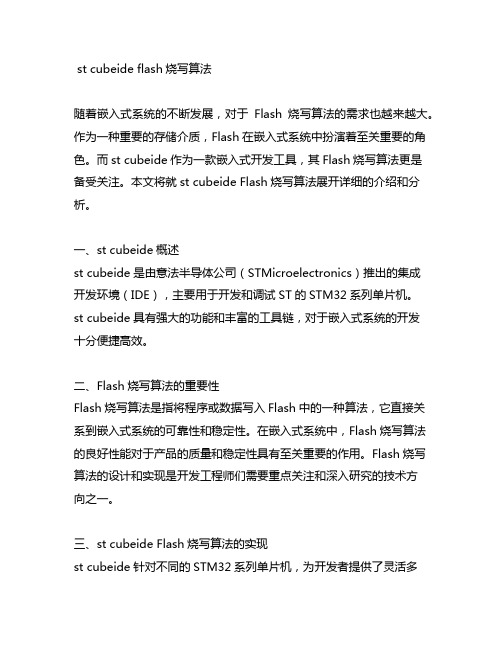
st cubeide flash烧写算法随着嵌入式系统的不断发展,对于Flash烧写算法的需求也越来越大。
作为一种重要的存储介质,Flash在嵌入式系统中扮演着至关重要的角色。
而st cubeide作为一款嵌入式开发工具,其Flash烧写算法更是备受关注。
本文将就st cubeide Flash烧写算法展开详细的介绍和分析。
一、st cubeide概述st cubeide是由意法半导体公司(STMicroelectronics)推出的集成开发环境(IDE),主要用于开发和调试ST的STM32系列单片机。
st cubeide具有强大的功能和丰富的工具链,对于嵌入式系统的开发十分便捷高效。
二、Flash烧写算法的重要性Flash烧写算法是指将程序或数据写入Flash中的一种算法,它直接关系到嵌入式系统的可靠性和稳定性。
在嵌入式系统中,Flash烧写算法的良好性能对于产品的质量和稳定性具有至关重要的作用。
Flash烧写算法的设计和实现是开发工程师们需要重点关注和深入研究的技术方向之一。
三、st cubeide Flash烧写算法的实现st cubeide针对不同的STM32系列单片机,为开发者提供了灵活多样的Flash烧写算法实现方式。
在st cubeide中,通过设置Flash烧写算法的参数、选择合适的算法模块等操作,即可轻松实现对Flash的烧写和擦除。
st cubeide灵活丰富的Flash烧写算法接口,使得开发者能够便捷快速地完成对Flash的操作,大大提高了开发效率。
四、st cubeide Flash烧写算法的优势相比于其他开发工具,st cubeide具有独特的优势和特点,使得其在Flash烧写算法的实现上具有明显的优势。
st cubeide提供了丰富的示例代码和文档,方便开发者学习和使用。
st cubeide具有友好的用户界面和强大的调试功能,能够帮助开发者快速定位和解决问题。
再次,st cubeide支持多种连接方式,包括仿真器、调试器等,满足不同场景下的需求。
飞比”Zigbee论坛CC2530开发板学习教程

“飞比”Zigbee论坛CC2530开发板学习教程(一)--前言“奥特曼Zigbee读书日记”已经写到第六部分了,首先非常感谢广大网友的支持与长期关注,此系列笔记会继续按照开源的方向进行深入的学习及更新。
同时,应广大网友的要求,也由于CC2530替代CC2430的强劲动力,经论坛管理团队讨论,最终决定在最近的一段时间内暂停“奥特曼Zigbee读书日记”的更新,而推出更偏向于应用,且更贴近市场的教程--“飞比”Zigbee论坛CC2530开发板学习教程。
本教程将着眼于TI公司的新一代 2.4G Zigbee IC-CC2530及最新的Zigbee协议-Zstack2007的应用学习。
所采用的硬件平台为CC2530的官方开发板-CC2530DK (SmartRF05EB)。
少一点炒作,多做一点实事--本站致力于营造一个“潜心学习、踏实做事”的氛围,希望广大Zigbee技术的爱好者、从业者积极参与,一起为中国的“无线单片机”技术献出自己的微薄之力。
[注:本文源自--“飞比”Zigbee论坛,为尊重劳动者成果,如需转载请保留此行,并通知作者]在这一章里,首先介绍下本套教程的整体思路及具体会涉及到的例程。
需要声明的一点是,本教程不是单片机的入门教程,需要读者对单片机及C语言有一定的基础,它关注的是Zigbee协议的基本概念及TI公司公开发行的免费Zigbee协议-Zstack 2007的应用。
首先着眼于TI公司提供的学习例程的讲解,这其中不但包括Zstack 2007的例程,同时会介绍TI的一些简化协议,如Basic RF/SimpliciTI等;然后会将“奥特曼Zigbee读书日记”中介绍的开源协议-MSSTATE LRWPAN,移植到CC2530DK中;最后,我们再来一起进入一个具体的应用领域-智能家居,学习一下TI的专用Zigbee遥控器协议RemoTI。
以下为具体采用的平台及相应的例程:(以下例程很多是CC2430及CC2530中共用的,本教程将同时适用)1、TI Basic RF----Light Switch----PER test2、Zstack 2007-----Sample App-----Generic App-----Home Automation-----Serial App-----Transmit App-----Simple App-----OAD/ENP/ESP等,待定3、MSSTATE LRWPAN ---- 平台移植及Ping Pong例程4、RemoTI声明:本教程中采用的源代码均来源于官方网站,并在此基础上进行修改,本站尊重原作者的劳动,将保留所有源文件的版权信息,并将标明本站进行的修改。
arduino入门教程

Arduino是什么?开始讲之前跟大家普及一个知识点,Arduino是一个意大利品牌。
Arduino是一个开放源码电子原型平台,拥有灵活、易用的硬件(各种开发板)和软件(arduino IDE也就是编程器)。
吉安优创电子科技有限公司作为arduino国内为数不多的正版授权公司,坚持正版。
打击抵制各类盗版,改版,兼容版的侵权行为,也奉劝广大消费者不要去购买,以免带来不必要的麻烦。
Arduino专为设计师,工艺美术人员,业余爱好者,以及对开发互动装置或互动式开发环境感兴趣的人而设的。
Arduino能通过各种各样的传感器来感知环境,通过控制灯光、马达和其他的装置来反馈、影响环境。
板子上的微控制器可以通过Arduino的编程语言来编写程序,编译成二进制文件,烧录进微控制器对Arduino的编程是利用 Arduino编程语言 (基于 Wiring)和Arduino开发环境(based on Processing)来实现的。
基于Arduino的项目,可以只包含Arduino,也可以包含Arduino和其他一些在PC上运行的软件,他们之间进行通信 (比如 Flash, Processing, MaxMSP)来实现。
如何学习arduino认识Arduino UNOArduino UNO是Arduino入门的最佳选择,在编著本书时,其最新的版本为UNO R3,本书大部分内容都是基于Arduino UNO R3写成的。
Arduino UNO的详细组成信息如下图所示。
1. 电源(Power)Arduino UNO有三种供电方式:●通过USB接口供电,电压为5V;●通过DC电源输入接口供电,电压要求7~12V;●通过电源接口处5V或者VIN端口供电,5V端口处供电必须为5V,VIN端口处供电为7~12V。
2.指示灯(LED)Arduino UNO带有4个LED指示灯,作用分别是:● ON,电源指示灯。
当Arduino通电时,ON灯会点亮。
STM32F429I-DISCO开发板用户手册说明书

Open429Z-D User ManualContents1. Hardware introduction (2)1.1. What’s on board (2)2. Demo (4)2.1. ADC+DMA (4)2.2. CAN1 TO CAN2-Normal (5)2.3. DAC (5)2.4. DS18B20 (6)2.5. OV2640 (6)2.6. GPIO_Key (7)2.7. I2C (7)2.8. I2S_UDA1380 (8)2.9. NandFlash_SCB0 (8)2.10. SAI (9)2.11. SD_FatFS (9)2.12. SDIO (9)2.13. SPI (10)2.14. USART (11)3. Version update records (11)1. Hardware introduction 1.1. What’s on board[ Core interface ]1. STM32F429I-DISCO socketfor easily connecting the STM32F429I-DISCO 2. MCU pins connectorall the MCU I/O ports are accessible onexpansion connectors for further expansion 3. USB connectorUSB to UART via PL2303 USB TO UART board onboard MCU4. I2C1 / I2C2interface[ Other interfaces ]16. 5V DC jack17. 5V/3.3 V power input/outputusually used as power output, alsocommon-grounding with other user board 18. JTAG/SWD interfacefor debugging/programming[ Jumper ]easily connects to I2C peripherals such as I/O expander (PCF8574), FRAM (FM24CLXX), etc. 5. I2S2 / I2S3 / I2C1 interfacefor connecting I2S peripherals, such as Audio module.6. DCMI interfacefor connecting camera module 7. SDIO interfacefor connecting Micro SD module, features much faster access speed rather than SPI 8. CAN1 interfacecommunicates with accessory boards which feature the CAN device conveniently 9. CAN2 interfacecommunicates with accessory boards which feature the CAN device conveniently 10. UART3 interfaceeasily connects to RS232, RS485, USB TO 232, etc11. SPI1/SPI4 + AD/DA interfaceeasily connects to SPI peripherals such as DataFlash (AT45DBxx), SD card, MP3 module, etc MP3SPI1 features AD/DA alternative function, supports connecting AD/DA module as well 12. UART2 interfaceeasily connects to RS232, RS485, USB TO 232, etc13. 8-bit FSMC interfaceeasily connects to peripherals such as NandFlash, Ethernet, etc 14. SAI1 interfacefor connecting Audio peripherals, such as UDA1380 etc15. One-WIRE interfaceeasily connects to ONE-WIRE devices (TO-92 package), such as temperature sensor (DS18B20), electronic registration number (DS2401), etc.16. Joystick jumpershort the jumper to connect the joystick to default I/Os used in example code;open the jumper to connect the joystick to custom I/Os via jumper wires. 17. BOOT mode switchfor configuring BOOT0 pin 18. USB TO UART jumper[ Components ] 16. AMS1117-3.33.3V voltage regulator 17. PL2303USB to UART MCU 18. 5V DC jack 19. Power LED20. UART1 indicator LED 21. Joystickfive positions2. DemoKEIL MDK Version :4.7Programmer/Debugger: STM32F429I-DISCO onboard ST-LINK V2 Programming/Debugging interface: SWDConnect PC to the onboard USB TO UART connector via USB wireSerial port settings:2.1. ADC+DMA◆ OverviewAD acquisition demo◆ Hardware connectionConnect Analog Test Boardto SPI1(ADC+DAC )connector◆ Operation and resultRotate the onboard potentiometer, the below message will be printed on the serial debugging assistant:Select a proper COM port Baud rate115200Data bits 8Stop bits 1 Parity bits None Flow controlNone2.2. CAN1 TO CAN2-Normal◆ OverviewCAN demo◆ Hardware connection◆ Hardware connectionConnect the two CAN modules to theonboard CAN interfaces◆ Operation and resultYou may see the below result on the serial debugging assistant:2.3. DAC◆ OverviewDAC demo◆ Hardware connectionConnect the Analog Test Board to the SPI1(ADC+DAC )connectorConnect the Analog Test Board onboard 5Vinterface to the board onboard 5V interface viajumper wire.◆ Operation and resultYou may hear sound from the Analog Test Board2.4. DS18B20◆ OverviewDS18B20 demo◆ Hardware connectionConnect the DS18B20 module to the one-wire connector ◆ Operation and resultThe below information will be printed on the serial debugging assistant2.5. OV2640◆ OverviewCamera OV2640 demo ◆ Hardware connectionConnect the OV2640 Camera Board tothe onboard DCMMI connectorLaunch the serial debugging assistant, configuring the data as below: COM: COM3Baud rate: 115200 Data bits: 8 Parity bits: NO Stop bits: 1◆ Operation and result:Press “user” key, the captured image displayed on the serial debugging assistant:2.6. GPIO_Key◆ Overviewjoystick demo◆ Hardware connectionShort the JOYSTICK JMP on board ◆ Operation and resultPress the joystick, message will be printed on the serial debugging assistant accordingly.2.7. I2C◆ OverviewI2C EEPROM demo ◆ Hardware connectionConnect the AT24/FM24 Board to the board viaI2C connector (I2C1 or I2C2, depending on the software configuration).◆ Software configurationThe module connect to I2C1 connectorThe module connect to I2C2 connector #define Open_I2C1 //#define Open_I2C2//#define Open_I2C1 #define Open_I2C2◆ Operation and resultThe below information will be printed on the serial debugging assistant:2.8. I2S_UDA1380◆ OverviewI2S_UDA1380 demo ◆ Hardware connectionConnect the UDA1380 Board to the board via I2Sconnector.Connect the earphone to the UDA1380 Board viaLINEOUT connector◆ Operation and resultYou should hear music when press the RESET key2.9. NandFlash_SCB0◆ OverviewNandFlash demo ◆ Hardware connectionConnect the NandFlash Board to theboard via I2C2 connector.◆ Operation and resultThe below information will be printed on the serial debugging assistant:2.10. SAI◆ OverviewSAI demo◆ Hardware connectionConnect UDA1380 Board to the board via SAI1connector.Connect the earphone to the UDA1380 Board viaLINEOUT connector.◆ Operation and resultYou should hear music when press the RESET key.2.11. SD_FatFS◆ OverviewSD_FatFS demo ◆ Hardware connectionConnect the Micro SD Storage Board to theboard via SDIO connector.Insert the SD card to the Micro SD Storage Board socket.◆ Operation and resultMessage will be printed on the serial debugging assistant.2.12. SDIO◆ OverviewSDIO demo◆Hardware connectionConnect the Micro SD Storage Board to theboard via SDIO connector.Insert the SD card to the Micro SD Storage Board socket.◆ Operation and resultMessage will be printed on the serial debugging assistant.2.13. SPI◆ OverviewSPI demo◆ Hardware connectionConnect the AT45DBXX DataFlash Board via SPIconnector. (SPI1 or SPI4, depending on the software configuration◆ Software connectionModule connect to SPI1 connectorModule connect toSPI4 connector #define Open_SPI1 //#define Open_SPI4//#define Open_SPI1 #define Open_SPI4◆ Operation and resultInfo/messages printed on the serial debugging assistant:11 2.14. USART◆ OverviewUSART demo◆ Hardware connection◆ Operation and resultInfo/messages printed on the serial debugging assistant:3. Version update records VersionModification Date Author V1.0Initial Release 2014/05/17 Waveshare team。
MSP单片机(精品)
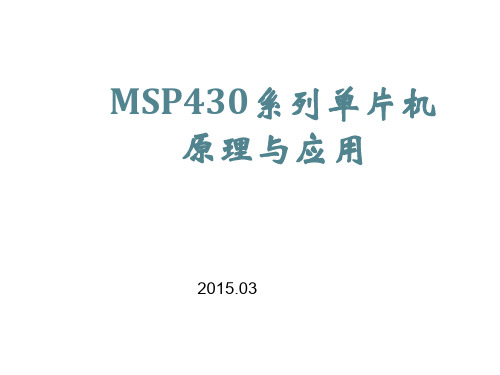
单片机的发展趋势
» 单片机发展为嵌入式处理器 单片机位数从4位、8位提高到16位、32位,从单CPU向多CPU发展。32位单片机由 于处理能力和开发方法已经和传统的单片机大相径庭,一般被称为嵌入式处理器, 成为数字系统设计的另外一个分支。
» 集成度进一步提高 单片机内部集成的设备越来越多,包括SRAM、FLASH ROM、E2ROM、AD、DA、PWM、 UART控制器、I2C控制器、 USB控制器、看门狗、上电复位电路、RC振荡器、FPGA 等,真正做到了SOC。
Z80 、MC6800系列等
Z80系列是8051系列流行之前非常流行的单片机,目前几乎没有人使用; 6800系列是Motorola公司80年代末推出的产品,采用RISC结构,成本低廉; 在低端大批量中占有优势。
目前热门的单片机(1)
51增强系列
8051为Intel公司80年代初推出,是目前普及度最广、兼容品种 最多的单片机。标准8051速度较慢,需要12个时钟周期运行一 条指令;目前出现了各大公司都推出了高速的8051兼容内核, 典型的是Dallas公司设计的4指令周期8051内核和Cignal公司研 发的单指令周期8051内核,Cignal公司的增强8051内核运行大 部分指令仅需要一个时钟周期,最快的型号已经达到100Mips 的计算速度。
智能化的仪器仪表:单片机用于包括温度、湿度、流量、流速、电压、 频率、功率、厚度、角度、长度、硬度、元素测定等和各类仪器仪表 中,使仪器仪表数字化、智能化、微型化,功能大大提高。
日常生活中的电器产品:单片机可用于电子秤、录像机、录音机、彩 电、洗衣机、高级电子玩具、冰箱、照相机、家用多功能报警器等。
MSP430系列单片机 原理与应用
2015.03
PFC基础知识及FOC工作原理
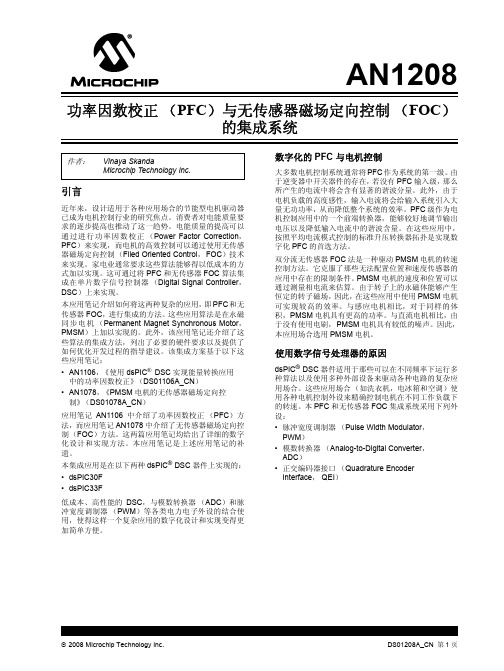
无传感器 FOC 法采用相电流 Ia 和 Ib 作为反馈信号。而 第三相电流 Ic 是通过进行数字化计算得到的。这三相电 流在用 Park 变换转化为转子系下两相电流之前,先用 Clarke 变换转化为定子系下的两相电流。这种转换得到 了两个计算电流分量:Id 和 Iq。磁链是电流 Id 的函数, 而转子转矩是电流 Iq 的函数。 位置估计器用于估计转子位置和速度信息。电机模型使 用电压和电流来估算位置。电机模型主要使用位置观测 器来间接获得转子位置信息。PMSM 模型是基于直流电 机模型。
2Φ 转子系统
Θ
Iq
Iα
α−β
Id
至 d-q
Iβ
2Φ 定子系统
无传感器磁场定向控制(FOC)系统
Ia
a, b, c
至
Ib
α−β
3Φ 定子系统
本页已使用福昕阅读器进行编辑。
AN1208 福昕软件(C)2005-2010,版权所有,
仅供试用。
DS01208A_CN 第 3 页
AN1208
数字化的功率因数校正
本集成应用是在以下两种 dsPIC® DSC 器件上实现的:
• dsPIC30F
• dsPIC33F
低成本、高性能的 DSC,与模数转换器 (ADC)和脉 冲宽度调制器 (PWM)等各类电力电子外设的结合使 用,使得这样一个复杂应用的数字化设计和实现变得更 加简单方便。
数字化的 PFC 与电机控制
大多数电机控制系统通常将 PFC 作为系统的第一级。由 于逆变器中开关器件的存在,若没有 PFC 输入级,那么 所产生的电流中将会含有显著的谐波分量。此外,由于 电机负载的高度感性,输入电流将会给输入系统引入大 量无功功率,从而降低整个系统的效率。PFC 级作为电 机控制应用中的一个前端转换器,能够较好地调节输出 电压以及降低输入电流中的谐波含量。在这些应用中, 按照平均电流模式控制的标准升压转换器拓扑是实现数 字化 PFC 的首选方法。
MSP-EXP430G2开发板使用简单介绍
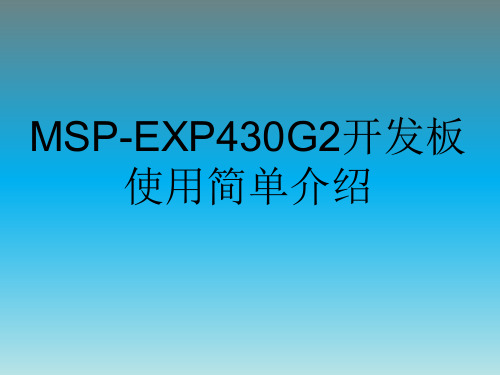
(5)、中断应用程序举例(外部中断):
void interrupt_initial() { P1DIR&=~BIT7; //P1.7为输入 P1IE|=0x80; //P1.7中断允许 P1IES|=0x00; //P1.7上升沿触发 P1IFG=0; //P1.7中断标志清除,对于多源中断必须先清中断标志再打开中断 _EINT(); //总中断允许 } #pragma vector=PORT1_VECTOR __interrupt void Port_1(void) { P1IFG&=~BIT7; //P1.7中断标志清除 /*在此写中断服务子程序*/ }
(4)、中断的嵌套:
当同时有多个中断来的时候才有优先级的考虑(优先级顺序可查看向量表)
实现中断嵌套需要注意以下几点: 1)430默认的是关闭中断嵌套的,一定要中断嵌套的话,就必须在中断服务程序中打开 总中断 msp430的指令中,_DINT()和_EINT()分别指关和开总中断。 2)当进入中断服务程序时,只要不在中断服务程序中再次开中断,则总中断是关闭的, 此时来中断不管是比当前中断的优先级高还是低都不执行; 3)若在中断服务程序A中开了总中断,则可以响应后来的中断B(不管B的优先级比A高 还是低),B执行完再继续执行A。注意:进入中断服务程序B后总中断同样也会关闭, 如 果B中断程序执行时需响应中断C,则此时也要开总中断,若不需响应中断,则不用 开中断,B执行完后跳出中断程序进入A程序时,总中断会自动打开; 4)若在中断服务程序中开了总中断,后来的中断同时有多个,则会按优先级来执行,即 中断优先级只有在多个中断同时到来时才起做用!中断服务不执行抢先原则。 5)对于单源中断,只要响应中断,系统硬件自动清中断标志位,对于TA/TB定时器的比较/捕 获中断,只要访问TAIV/TBIV,标志位倍被自动清除; 对于多源中断要手动清标志位,比如P1/P2口中断,要手工清除相应的标志,如果在这种中 断用"EINT();"开中断,而在打开中断前没有清标志,就会 有相同的中断不断嵌入,而导致 堆栈溢出引起复位,所以在这类中断中必须先清标志再打开中断开关.
ide知识点大全
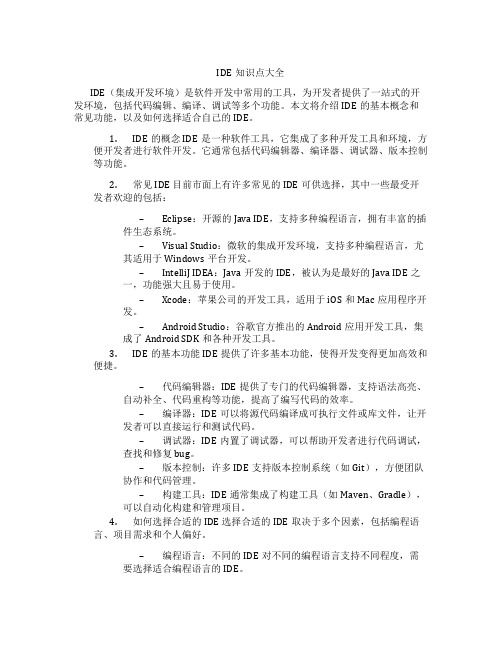
IDE知识点大全IDE(集成开发环境)是软件开发中常用的工具,为开发者提供了一站式的开发环境,包括代码编辑、编译、调试等多个功能。
本文将介绍IDE的基本概念和常见功能,以及如何选择适合自己的IDE。
1.IDE的概念 IDE是一种软件工具,它集成了多种开发工具和环境,方便开发者进行软件开发。
它通常包括代码编辑器、编译器、调试器、版本控制等功能。
2.常见IDE 目前市面上有许多常见的IDE可供选择,其中一些最受开发者欢迎的包括:–Eclipse:开源的Java IDE,支持多种编程语言,拥有丰富的插件生态系统。
–Visual Studio:微软的集成开发环境,支持多种编程语言,尤其适用于Windows平台开发。
–IntelliJ IDEA:Java开发的IDE,被认为是最好的Java IDE之一,功能强大且易于使用。
–Xcode:苹果公司的开发工具,适用于iOS和Mac应用程序开发。
–Android Studio:谷歌官方推出的Android应用开发工具,集成了Android SDK和各种开发工具。
3.IDE的基本功能 IDE提供了许多基本功能,使得开发变得更加高效和便捷。
–代码编辑器:IDE提供了专门的代码编辑器,支持语法高亮、自动补全、代码重构等功能,提高了编写代码的效率。
–编译器:IDE可以将源代码编译成可执行文件或库文件,让开发者可以直接运行和测试代码。
–调试器:IDE内置了调试器,可以帮助开发者进行代码调试,查找和修复bug。
–版本控制:许多IDE支持版本控制系统(如Git),方便团队协作和代码管理。
–构建工具:IDE通常集成了构建工具(如Maven、Gradle),可以自动化构建和管理项目。
4.如何选择合适的IDE 选择合适的IDE取决于多个因素,包括编程语言、项目需求和个人偏好。
–编程语言:不同的IDE对不同的编程语言支持不同程度,需要选择适合编程语言的IDE。
–项目需求:一些IDE专注于特定类型的项目开发,如移动应用开发、Web开发等,需要根据项目需求选择合适的IDE。
Arduino开发板入门教程

Arduino开发板入门教程第一章:Arduino简介Arduino是一款开源硬件平台,广泛应用于物联网、机器人和自动化领域。
它由一个简单易用的硬件开发板和一个基于Java的集成开发环境(IDE)组成。
本章将介绍Arduino的基本知识和原理。
1.1 Arduino开发板的组成Arduino开发板包含一个微控制器、一组输入输出引脚和一些其他的电子元件。
常用的Arduino型号有Arduino Uno、Arduino Nano和Arduino Mega等。
1.2 Arduino的特点和应用Arduino具有开源、低成本、易使用和可扩展的特点,使其成为广大电子爱好者和创客的首选。
它可以用于建造简单的电子装置、控制传感器、驱动电机以及与计算机进行通信等。
第二章:Arduino的基本用法本章将详细介绍Arduino的基本用法,包括设置Arduino开发环境、编写代码、上传程序以及与外部电路的连接。
2.1 Arduino开发环境的安装与设置首先,需要从Arduino官方网站上下载并安装Arduino集成开发环境(IDE)。
安装完成后,用户需要选择合适的开发板和端口。
2.2 Arduino编程基础Arduino使用一种类似C语言的编程语言。
本节将介绍Arduino编程的基本结构、语法和常用函数。
同时,还将介绍数字输入/输出、模拟输入/输出和串口通信等常用功能。
2.3 Arduino程序的上传编写好的Arduino程序需要通过USB接口将代码上传到开发板上。
本节将介绍如何将程序上传到Arduino开发板,并进行调试和测试。
2.4 Arduino与外部电路的连接Arduino开发板上有多个数字引脚和模拟引脚,可以与外部电路进行连接。
本节将介绍如何使用面包板和杜邦线将Arduino与LED、电位器、温度传感器等外部元件进行连接,并通过编写程序进行控制和读取。
第三章:Arduino的高级用法在本章中,将介绍一些Arduino的高级应用,包括使用库函数、扩展Arduino功能以及与其他设备的通信等。
第0章 Arduino 概述

0.1 初识Arduino
0.1 初识Arduino
0.1.1 Arduino简介
Arduino是一款便捷灵活、方便上手的开源电子原型平台。包含硬件(各种型 号的Arduino板)和软件(Arduino IDE)。由一个欧洲开发团队于2005年冬季 开发。其成员包括Massimo Banzi、David Cuartielles、Tom Igoe、Gianluca Martino、David Mellis和Nicholas Zambetti。
Arduino技术及应用
第 0 章 Arduino概述Biblioteka 第 0 章 Arduino概述
本章主要从初识Arduino、Arduino的由来、为什么使用 Arduino作为开发平台三个方面对Arduino进行概述,为后 续学习打下基础。
目录
1
初识Arduino
2
Arduino的由来
3
选择理由
4
嵌本入章式小系结统应用
0.2.1 Arduino的历史
随后Banzi、Cuartielles和Mellis把设计图放到了网上。版权法可以监管开源软 件,却很难用在硬件上,为了保持设计的开放源码理念,他们决定采用Creative Commons(CC)的授权方式公开硬件设计图。在这样的授权下.任何人都可以生 产电路板的复制品,甚至还能重新设计和销售原设计的复制品。人们不需要支 付任何费用,甚至不用取得Arduino团队的许可。然而,如果重新发布了引用设 计,就必须声明原始Arduino团队的贡献。如果修改了电路板,则最新设计必须 使用相同或类似的Creative Commons(CC)的授权方式,以保证新版本的Arduino 电路板也会一样是自由和开放的。唯一被保留的只有Arduino这个名字,它被注 册成了商标,在没有官方授权的情况下不能使用它。
TI MSP430FR2355超低功耗开发方案
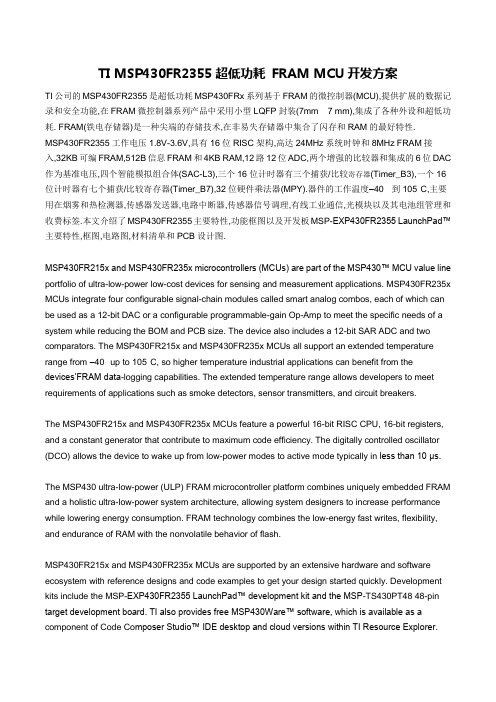
TI MSP430FR2355超低功耗FRAM MCU开发方案TI公司的MSP430FR2355是超低功耗MSP430FRx系列基于FRAM的微控制器(MCU),提供扩展的数据记录和安全功能,在FRAM微控制器系列产品中采用小型LQFP封装(7mm × 7 mm),集成了各种外设和超低功耗. FRAM(铁电存储器)是一种尖端的存储技术,在非易失存储器中集合了闪存和RAM的最好特性.MSP430FR2355工作电压1.8V-3.6V,具有16位RISC架构,高达24MHz系统时钟和8MHz FRAM接入,32KB可编FRAM,512B信息FRAM和4KB RAM,12路12位ADC,两个增强的比较器和集成的6位DAC 作为基准电压,四个智能模拟组合体(SAC-L3),三个16位计时器有三个捕获/比较寄存器(Timer_B3),一个16位计时器有七个捕获/比较寄存器(Timer_B7),32位硬件乘法器(MPY).器件的工作温度–40°到105°C,主要用在烟雾和热检测器,传感器发送器,电路中断器,传感器信号调理,有线工业通信,光模块以及其电池组管理和收费标签.本文介绍了MSP430FR2355主要特性,功能框图以及开发板MSP-EXP430FR2355 LaunchPad™主要特性,框图,电路图,材料清单和PCB设计图.MSP430FR215x and MSP430FR235x microcontrollers (MCUs) are part of the MSP430™ MCU value line portfolio of ultra-low-power low-cost devices for sensing and measurement applications. MSP430FR235x MCUs integrate four configurable signal-chain modules called smart analog combos, each of which can be used as a 12-bit DAC or a configurable programmable-gain Op-Amp to meet the specific needs of a system while reducing the BOM and PCB size. The device also includes a 12-bit SAR ADC and two comparators. The MSP430FR215x and MSP430FR235x MCUs all support an extended temperature range from –40° up to 105°C, so higher temperature industrial applications can benefit from the devices’FRAM data-logging capabilities. The extended temperature range allows developers to meet requirements of applications such as smoke detectors, sensor transmitters, and circuit breakers.The MSP430FR215x and MSP430FR235x MCUs feature a powerful 16-bit RISC CPU, 16-bit registers, and a constant generator that contribute to maximum code efficiency. The digitally controlled oscillator (DCO) allows the device to wake up from low-power modes to active mode typically in less than 10 μs.The MSP430 ultra-low-power (ULP) FRAM microcontroller platform combines uniquely embedded FRAM and a holistic ultra-low-power system architecture, allowing system designers to increase performance while lowering energy consumption. FRAM technology combines the low-energy fast writes, flexibility, and endurance of RAM with the nonvolatile behavior of flash.MSP430FR215x and MSP430FR235x MCUs are supported by an extensive hardware and software ecosystem with reference designs and code examples to get your design started quickly. Development kits include the MSP-EXP430FR2355 LaunchPad™ development kit and the MSP-TS430PT48 48-pin target development board. TI also provides free MSP430Ware™ software, which is available as a component of Code Co mposer Studio™ IDE desktop and cloud versions within TI Resource Explorer.The MSP430 MCUs are also supported by extensive online collateral, training, and online support through the E2E™ community forum.MSP430FR2355主要特性:• Embedded microcontroller– 16-bit RISC architecture up to 24 MHz– Extended temperature: –40°C to 105°C– Wide supply voltage range from 3.6 V down to 1.8 V (operational voltage is restricted by SVS levels, see VSVSH- and VSVSH+ in PMM, SVS and BOR)• Optimized low-power modes (at 3 V)–Active mode: 142 μA/MHz– Standby:– LPM3 with 32768-Hz crystal: 1.43 μA (with SVS enable d)– LPM3.5 with 32768-Hz crystal: 620 nA (with SVS enabled)– Shutdown (LPM4.5): 42 nA (with SVS disabled)• Low-power ferroelectric RAM (FRAM)– Up to 32KB of nonvolatile memory– Built-in error correction code (ECC)– Configurable write protection– Unified memory of program, constants, and storage– 1015 write cycle endurance– Radiation resistant and nonmagnetic• Ease of use– 20KB ROM library includes driver libraries and FFT libraries• High-performance analog– One 12-channel 12-bit analog-to-digital converter (ADC)– Internal shared reference (1.5, 2.0, or 2.5 V)– Sample-and-hold 200 ksps– Two enhanced comparators (eCOMP)– Integrated 6-bit digital-to-analog converter (DAC) as reference voltage– Programmable hysteresis– Configurable high-power and low-power modes– One with fast 100-ns response time– One with 1-μs response time with 1.5-μA low power– Four smart analog combo (SAC-L3) (MSP430FR235x devices only)– Supports General-Purpose Operational Amp lifi er (OA)– Rail-to-rail input and output– Multiple input selections– Configurable high-power and low-power modes– Configurable PGA mode supports– Noninverting mode: ×1, ×2, ×3, ×5, ×9, ×17, ×26, ×33– Inverting mode: ×1, ×2, ×4, ×8, ×16, ×25, ×32– Built-in 12-bit reference DAC for offset and bias settings– 12-bit voltage DAC mode with optional references• Intelligent digital peripherals– Three 16-bit timers with three capture/compare registers each (Timer_B3)– One 16-bit timer with seven capture/compare registers each (Timer_B7)– One 16-bit counter-only real-time clock counter (RTC)– 16-bit cyclic redundancy checker (CRC)– Interrupt compare controller (ICC) enabling nested hardware interrupts– 32-bit hardware multiplier (MPY32)– Manchester codec (MFM)• Enhanced serial communications– Two enhanced USCI_A (eUSCI_A) modules support UART, IrDA, and SPI– Two enhanced USCI_B (eUSCI_B) modules support SPI and I2C• Clock system (CS)– On-chip 32-kHz RC oscillator (REFO)– On-chip 24-MHz digitally controlled oscillator (DCO) with frequency locked loop (FLL) – ±1% accuracy with on-chip reference at room temperature– On-chip very low-frequency 10-kHz oscillator (VLO)– On-chip high-frequency modulation oscillator (MODOSC)– External 32-kHz crystal oscillator (LFXT)– External high-frequency crystal oscillator up to 24 MHz (HFXT)– Programmable MCLK prescaler of 1 to 128– SMCLK derived from MCLK with programmable prescaler of 1, 2, 4, or 8• General input/output and pin functionality– 44 I/Os on 48-pin package– 32 interrupt pins (P1, P2, P3, and P4) can wake MCU from LPMs• Development tools and software (also see Tools and Software)–LaunchPad™ development kit (MSP-EXP430FR2355)– Target development board (MSP-TS43048PT)– Free professional development environments• Family members (also see Device Comparison)– MSP430FR2355: 32KB of program FRAM, 512 bytes of data FRAM, 4KB of RAM– MSP430FR2353: 16KB of program FRAM, 512 bytes of data FRAM, 2KB of RAM– MSP430FR2155: 32KB of program FRAM, 12 bytes of data FRAM, 4KB of RAM– MSP430FR2153: 16KB of program FRAM, 512 bytes of data FRAM, 2KB of RAM• Package options– 48-pin: LQFP (PT)– 40-pin: VQFN (RHA)– 38-pin: TSSOP (DBT)– 32-pin: VQFN (RSM)MSP430FR2355应用:• Smoke and heat detectors• Sensor transmitters• Circuit breakers• Sensor signal conditioning• Wired industrial communications• Optical modules• Battery pack management• Toll tags图1. MSP430FR235x系列功能框图开发板MSP-EXP430FR2355 LaunchP ad™MSP430FR2355 LaunchPad™ Development Kit (MSP-EXP430FR2355)The MSP-EXP430FR2355 LaunchPad™ Development Kit is an easy-to-use Evaluation Module (EVM) for the MSP430FR2355 microcontroller (MCU). The kit contains everything needed to start developing on the ultra-low-power MSP430FRx FRAM microcontroller platform, including onboard debug probe for programming, debugging, and energy measurements. The board also features onboard buttons and LEDs for quick integration of a simple user interface, an onboard Grove connector for external Grove sensors, as well as an ambient light sensor to showcase the integrated analog peripherals.The 24-MHz MSP430FR2355 device features 32KB of embedded FRAM (ferroelectric random access memory), a nonvolatile memory known for its ultra-low power, high endurance, and high speed write access. Combined with 4KB of on-chip RAM, users have access to 32KB of memory to split between their program and data as required. For example, a data logging application may require a large data memory with relatively small program memory, so the memory may be allocated as required between program and data memory.Rapid proto typing is simplified by the 40-pin BoosterPack™ plug-in module headers, which support a wide range of available BoosterPack plug-in modules. You can quickly add features like wireless connectivity, graphical displays, environmental sensing, and much more. Design your own BoosterPack plug-in module or choose among many already available from TI and third-party developers.开发板MSP-EXP430FR2355 LaunchPad™主要特性:• MSP ULP FRAM technology based MSP430FR2355 16-bit MCU• EnergyTrace technology available for ultra-low-power debugging• 40-pin LaunchPad development kit standard leveraging the BoosterPack plug-in module ecosystem • Onboar d eZ-FET debug probe• 2 buttons and 2 LEDs for user interaction• Ambient light sensor for the Out-of-Box Experience demo• Grove connector for external Grove sensors开发板MSP-EXP430FR2355 LaunchPad™包括:• 1 MSP-EXP430FR2355 LaunchPad Development Kit• 1 Mic ro USB cable• 1 Quick Start Guide图2. 开发板MSP-EXP430FR2355 LaunchPad™外形图图3. 开发板MSP-EXP430FR2355 LaunchPad™概述图图4. 开发板MSP-EXP430FR2355 LaunchPad™框图图5. 开发板MSP-EXP430FR2355 LaunchPad™电路图(1)图6. 开发板MSP-EXP430FR2355 LaunchPad™电路图(2)图7. 开发板MSP-EXP430FR2355 LaunchPad™ PCB设计图(1)图8. 开发板MSP-EXP430FR2355 LaunchPad™ PCB设计图(2)图9. 开发板MSP-EXP430FR2355 LaunchPad™ PCB设计图(3)图10. 开发板MSP-EXP430FR2355 LaunchPad™ PCB设计图(4)图11. 开发板MSP-EXP430FR2355 LaunchPad™ PCB设计图(5)图12. 开发板MSP-EXP430FR2355 LaunchPad™ PCB设计图(6)图13. 开发板MSP-EXP430FR2355 LaunchPad™ PCB设计图(7)图14. 开发板MSP-EXP430FR2355 LaunchPad™ PCB设计图(8)图15. 开发板MSP-EXP430FR2355 LaunchPad™ PCB设计图(9)图16. 开发板MSP-EXP430FR2355 LaunchPad™ PCB设计图(10)。
MSP-EXP430G2入门

提纲:一.MSP-EXP430G2套件介绍1.包装清单unchPad简介(430文件夹_用户指南)(一)LaunchPad片上资源(1)开发板硬件简介(2)主要功能模块(二)LaunchPad特性(三)LaunchPad电路图(主要参考【LaunchPad】开发板介绍.pdf)3.MSP430G2553数据资料(技术资料汇总_G2553中文资料.pdf)4.安装MSP-EXP430G2 LaunchPad二.编译部分1.编译工具的选择2.编译工具的安装(根据安装提示便可)3.程序编译、烧录流程4.编程规则(MSP430 编程规则.pdf)三.基础程序部分1.功能模块程序(MSP430G2xx3 Code Examples文件夹)2.基础应用程序(例程代码)四.应用举例——MSP430G2452内置温度传感器温度检测五.LaunchPad扩展部分1.eZ430连接、编程要点2.与卫星板的连接3.与LaunchPad兼容的MSP430器件一.MSP-EXP430G2套件介绍1.包装清单:⏹LaunchPad目标板(附一个烧好测温实验例程的MPS430G2553)⏹MPS4302452一个——具有8通道10位ADC、片上比较器、触控式I/O、通用串行接口、8Kb闪存、256字节SRAM的低功耗16位MSP430微控制器⏹32.768KHz时钟晶振⏹0.5m长的USB-B线缆⏹插座式10引脚印刷板连接线两个⏹LaunchPad贴签两个⏹快速启动指南unchPad简介(一)LaunchPad片上资源(1)开发板硬件介绍:板上材料清单开发板指示图(2)主要功能模块:⏹复位模块⏹时钟模块⏹I/O端口模块;⏹WDT看门狗模块;⏹Timer A定时器模块⏹比较器A模块⏹ADC10数模转换模块⏹USART串行异步通讯模块⏹CPU模块(二)LaunchPad特性⏹实验班成本低、低功耗⏹USB调试与编程接口无需驱动即可安装使用,且具备高达9600波特的UART串行通信速度⏹支持所有采用PDIP14或PDIP20封装的MSP430G2XX和MSP430F20XX器件⏹分别连接至绿光和红光LED的两个通用数字I/O口引脚可提供视觉反馈⏹两个按钮可实现用户反馈和芯片复位⏹器件引脚可通过插座引出,既可以方便的用于调试,也可用来添加定制的扩展板⏹高质量的20引脚DIP插座,可轻松简便地插入目标器件或将其移除(三)LaunchPad电路图LaunchPad原理图见“【LaunchPad】开发板介绍.pdf”。
DE0使用说明中文

5.1 DE0 默认配置 ................................................................................................................................... 42 5.2 SD 卡设计范例.................................................................................................................................. 43 5.3 VGA color pattern 设计范例............................................................................................................... 46
2
第1章.
DE0 包装
DE0 开发板套件包含了在 Windows 操作系统下运行所需的所有组件。
1.1 包装内容
DE0 开发板套件之包装图 1-1 所示。
DE0 开发板套件包含:
图 1-1 DE0 开发板套件包装 3
DE0 开发板 用于 FPGA 编程控制的 USB 电缆线 DE0 开发板系统 CD 包含:
早上
1
目录..............................................................................................3
1.1 包装内容............................................................................................................................................. 3 1.2 DE0 开发板组装 .................................................................................................................................. 4
stm32cubeide使用手册
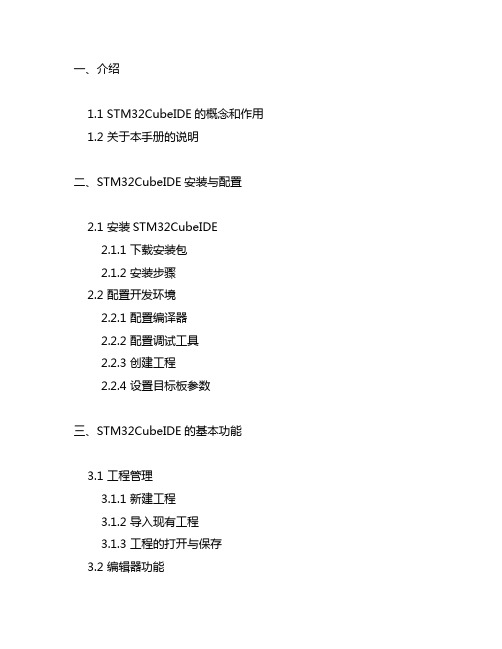
一、介绍1.1 STM32CubeIDE的概念和作用 1.2 关于本手册的说明二、STM32CubeIDE安装与配置2.1 安装STM32CubeIDE2.1.1 下载安装包2.1.2 安装步骤2.2 配置开发环境2.2.1 配置编译器2.2.2 配置调试工具2.2.3 创建工程2.2.4 设置目标板参数三、STM32CubeIDE的基本功能3.1 工程管理3.1.1 新建工程3.1.2 导入现有工程3.1.3 工程的打开与保存3.2 编辑器功能3.2.1 代码编辑3.2.2 代码自动补全3.2.3 代码格式化3.3 编译与调试3.3.1 编译工程3.3.2 调试工具的使用3.3.3 调试器的设置四、STM32CubeIDE的高级功能4.1 外设配置4.1.1 GPIO配置4.1.2 定时器配置4.1.3 中断配置4.2 调试技巧4.2.1 断点设置与查看4.2.2 寄存器查看与修改4.2.3 性能分析工具的使用五、STM32CubeIDE的进阶应用5.1 高级调试功能5.1.1 实时变量跟踪5.1.2 快速表达式评估5.2 优化技巧5.2.1 代码优化5.2.2 系统优化5.3 多工程协作5.3.1 项目管理5.3.2 版本控制六、常见问题与解决6.1 STM32CubeIDE常见问题6.1.1 编译失败6.1.2 调试器连接问题6.2 解决方案6.2.1 常见问题解决方法6.2.2 常见错误代码解析七、总结与展望7.1 对STM32CubeIDE使用手册的总结 7.2 未来发展展望---以上是文章的大致框架,你可以根据每个小节逐一展开相关内容,这样能够更好地为读者提供全面的使用指南。
在撰写文章时,要注重语言的规范和流畅度,避免使用口语化的词汇和表达方式。
结合具体的使用案例和应用场景来丰富文章内容,让读者更容易理解和接受。
希望这篇文章能够对你有所帮助。
STM32CubeIDE是一款集成开发环境,主要用于开发STM32微控制器的应用程序。
《匠人手记》17《天梯——MSP430之学习札记_第2部_》
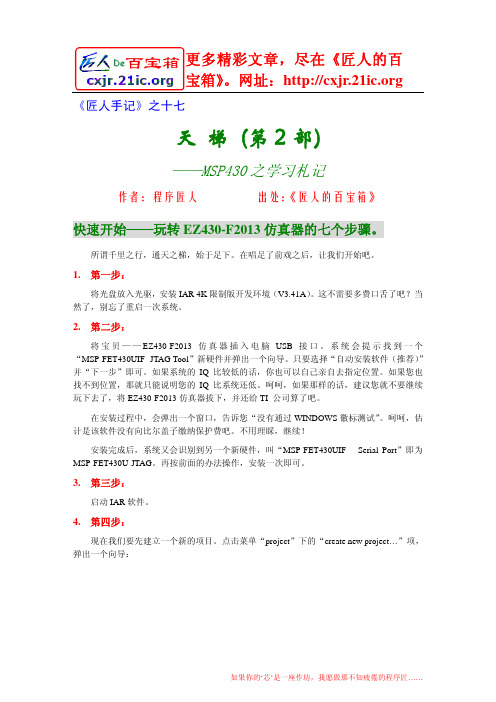
宝箱》。
网址: 《匠人手记》之十七天 梯 (第2部)——MSP430之学习札记作者:程序匠人 出处:《匠人的百宝箱》快速开始——玩转EZ430-F2013仿真器的七个步骤。
所谓千里之行,通天之梯,始于足下。
在唱足了前戏之后,让我们开始吧。
1.第一步:将光盘放入光驱,安装IAR 4K限制版开发环境(V3.41A)。
这不需要多费口舌了吧?当然了,别忘了重启一次系统。
2.第二步:将宝贝——EZ430-F2013仿真器插入电脑USB接口。
系统会提示找到一个“MSP-FET430UIF -JTAG Tool”新硬件并弹出一个向导。
只要选择“自动安装软件(推荐)”并“下一步”即可。
如果系统的IQ比较低的话,你也可以自己亲自去指定位置。
如果您也找不到位置,那就只能说明您的IQ比系统还低。
呵呵,如果那样的话,建议您就不要继续玩下去了,将EZ430-F2013仿真器拔下,并还给TI 公司算了吧。
在安装过程中,会弹出一个窗口,告诉您“没有通过WINDOWS徽标测试”。
呵呵,估计是该软件没有向比尔盖子缴纳保护费吧。
不用理睬,继续!安装完成后,系统又会识别到另一个新硬件,叫“MSP-FET430UIF – Serial Port”即为MSP-FET430U-JTAG。
再按前面的办法操作,安装一次即可。
3.第三步:启动IAR软件。
4.第四步:现在我们要先建立一个新的项目。
点击菜单“project”下的“create new project…”项,弹出一个向导:宝箱》。
网址:选择语言为C,并点击“OK”。
接下来选择项目路径和项目名称。
系统自动生成一个MAIN.C文件,内容包括:int main( void ){return 0;}我们向文件中输入以下内容:#include "msp430x20x3.h"void main(void){WDTCTL = WDTPW + WDTHOLD; // Stop watchdog timerP1DIR |= 0x01; // Set P1.0 to output directionfor (;;){volatile unsigned int i; // volatile to prevent optimization P1OUT ^= 0x01; // Toggle P1.0 using exclusive-ORi = 10000; // SW Delaydo i--;while (i != 0);}}这是一个最简单的程序,它的功能就是把P1.0 口不断取反,从而让LED闪烁。
MSP432P401R 用户指南
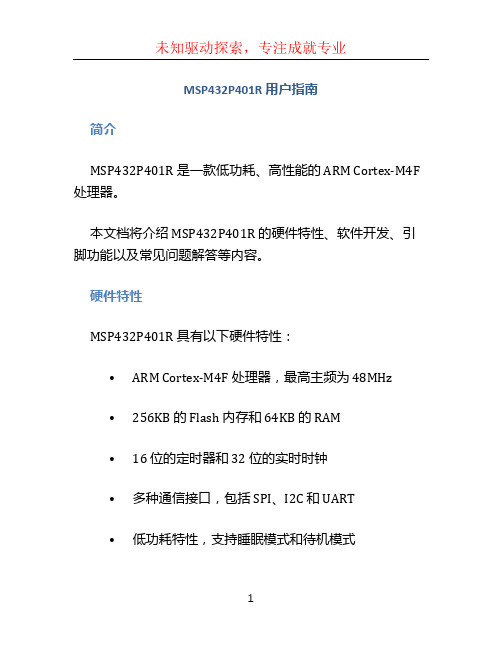
MSP432P401R 用户指南简介MSP432P401R 是一款低功耗、高性能的 ARM Cortex-M4F 处理器。
本文档将介绍 MSP432P401R 的硬件特性、软件开发、引脚功能以及常见问题解答等内容。
硬件特性MSP432P401R 具有以下硬件特性:•ARM Cortex-M4F 处理器,最高主频为 48MHz•256KB 的 Flash 内存和 64KB 的 RAM•16 位的定时器和 32 位的实时时钟•多种通信接口,包括 SPI、I2C 和 UART•低功耗特性,支持睡眠模式和待机模式软件开发开发环境搭建要开始使用 MSP432P401R 进行软件开发,您需要搭建适合的开发环境。
1.安装Code Composer Studio 集成开发环境(IDE)。
2.下载并安装 MSP432P401R 的驱动程序。
3.连接 MSP432P401R 开发板到计算机。
常用 APIMSP432P401R 提供丰富的软件库和 API,方便您进行应用开发。
以下是一些常用的 API:•GPIO:控制和管理引脚的输入和输出。
•UART:用于串行通信的通信接口。
•Timer:用于定时和计时的功能接口。
•ADC:用于模拟信号转数字信号的接口。
示例代码下面是一个简单的示例代码,演示了如何使用MSP432P401R 控制 LED 灯的开关状态。
#include <msp432p401r.h>void delay(int count) {int i;for (i = 0; i < count; i++) {__delay_cycles(400000);}}int main(void) {// 配置 P1.0 引脚为输出模式P1DIR |= BIT0;while (1) {// 点亮 LEDP1OUT |= BIT0;delay(1000);// 关闭 LEDP1OUT &= ~BIT0;delay(1000);}}此示例代码使用了 MSP432P401R 的 GPIO API 来控制 P1.0 引脚的输入和输出。
初学STM32CubeIDE

初学STM32CubeIDE一、关于安装安装已经有好多人说过了,我就不重复。
二、认识界面初初打开软件,自动打开“Information Center”就是信息中心。
我们点击“Read STM32CubeIDE Documentation”,再点击“STM32CubeIDE Qiuck Start Guide”就是快速启动手册。
简单介绍一下。
Note: workspace and project names must contain only ascii characters. This is also valid for the path to the workspace.注意:项目要用ascii字节。
工作空间名也要用ascii字节。
工作空间就是一个文件夹,用于作为STM32CubeIDE的存放暂时文件和记录文件的地方。
三、建工程工程不用建在工作空间中。
我喜欢各软件的工程集中放一起,再区分一个个软件专用的工程文件夹。
菜单“File”-“New”-“STM32 Project”或者“Start new STM32 project”链接,则启动新建工程。
工程的第一步:选择芯片,可以通过左则输入型号,快速选出;或者通过下拉框的过滤,最后选定型号。
工程的第二步:项目的名字,还的选项。
名字不要用中文,要用ascii。
选项默认就可以,用C语言,输入单片机程序。
工程的第三步:这里我也看不明白,点“Finish”(完成)就好了。
建工程前和后比较卡,这是在下载。
四、设定时基看看电路图,我发现晶振两块,一块是8MHz,另一块是32.768KHz。
那么对应高速时钟是来自晶振8MHz。
低速时钟是来自晶振32.768KHz。
那么我点开“System Core”,选中“RCC”。
对应HSE下拉选“Crystal/Ceramic Resonator”这是晶振的意思。
“BYPASS Clock Source”意思是指线输入路时钟源。
- 1、下载文档前请自行甄别文档内容的完整性,平台不提供额外的编辑、内容补充、找答案等附加服务。
- 2、"仅部分预览"的文档,不可在线预览部分如存在完整性等问题,可反馈申请退款(可完整预览的文档不适用该条件!)。
- 3、如文档侵犯您的权益,请联系客服反馈,我们会尽快为您处理(人工客服工作时间:9:00-18:30)。
开箱时里面的介绍:
整体布局介绍:
英文版:
翻译版:
MSP432P401:
板子上面为仿真电路和功耗测量电路,下面为432主控芯片和外围器件
我用的开发环境是,他的版本号是
(通过
方式查看版本号)
MSP432处理器也可以用库函数和寄存器两种方式来编写程序的,库函数是用的最多的方式,我也用库函数的方式来编写MSP432的程序。
MSP432P401R LaunchPad包含48MHz ARM CortexM4F内核,95uA/MHz工作功耗和850nA RTC操作,14位1MPS差动SAR ADC和AES256加速器。
评估板包含带有EnergyTrace+技术的板载仿真器,无需其他工具即可进行项目编程和调试,同时还可以测量系统总能耗。
P432P401R 处理器特性
低功耗、高性能MSP432P401R MCU
带浮点单元和DSP 加速功能的48MHz 32 位ARM Cortex M4F
功耗:95uA/MHz 工作功耗和850nA RTC 待机操作功耗
模拟:24 通道14 位差动1MSPS SAR ADC,两个比较器
数字:高级加密标准(AES256) 加速器、CRC、DMA、32 位硬件乘法器
存储器:256KB 闪存、64KB RAM
计时器:4 个16 位、2 个32 位
通信:多达4 个I2C、8 个SPI、4 个UART
40 引脚BoosterPack 连接器,支持20 引脚BoosterPack
采用EnergyTrace+ 技术的板载XDS-110ET 仿真器
2 个按钮和2 个LCD,便于用户交互
反向通道UART 通过USB 连接到PC
更多关于MSP432的资料:
MSP432处理器可以使用CCS、IAR和keil uVision IDE来开发整块电路板的框图:
以电路板上中间的虚线划分为上下两部分,介绍一下上面部分,
上面部分是XDS110-ET仿真器,
评估板也可以外接仿真器,S101开关()来选择板载XDS110仿真器还是用外部仿真器
MSP432P401R与XDS110ET的连接可以断开,MSP432P401R与XDS110-ET除仿真信号之外没有其他通讯连接,仿真信号包括XDS110-ET串行调试信号、应用UART信号和、5V电源。
下面的图表很清楚的描述了两个区域的连接情况:
信号连接方式描述
5V 跳线USB过来的5V电源
3V3 跳线从XDS110-ET过来的
RTS 跳线UART通道
CTS 跳线UART通道
RXD 跳线接收数据
TXD 跳线发送数据
RST 按键复位MCU
TCK-SWCLK 拨动开关串行输入/JTAG输出
注:RTS和CTS为串口通讯时的半双工通信。
